As Italy’s digital landscape grows, creating Italian-specific content is crucial for reaching Italian-speaking audiences and engaging effectively in Italian media spaces. From Italian brands seeking to localize their ads on RAI and Mediaset to content creators aiming for Italian-speaking audiences on podcasts like Il Ruggito del Coniglio or Muschio Selvaggio, AI-powered dubbing offers accessible and efficient solutions. In this guide, we’ll explore Italian dubbing options, compare traditional dubbing techniques with AI voice generators and teach you how to dub a video in Italian using AI voices.
What is Italian Dubbing?
Italian dubbing involves translating audio or video content into Italian and syncing the translated speech with the original video to ensure a seamless experience for viewers. This process requires a careful balance of translation accuracy, voice style, and cultural adaptation, especially in popular Italian-dubbed media. Effective Italian dubbing takes into account cultural nuances, regional accents, and variations in formality that make the content resonate naturally with an Italian-speaking audience.
For instance, Italian has distinct forms for addressing others, with "tu" as the informal "you" and "Lei" for formal situations, impacting how authentic the dialogue feels. The inclusion of Italian idioms like "in bocca al lupo" (meaning "good luck") and conversational expressions creates a sense of familiarity and relatability for viewers. Dubbing for the Italian market isn’t only about linguistic accuracy—it’s about crafting an immersive cultural experience that feels genuine to Italian audiences.
Italian Dubbing Options: Traditional vs. AI Video Dubbing
Italian dubbing traditionally relied on voice actors to interpret scripts and synchronize their performances with on-screen characters. AI dubbing, however, introduces an efficient and versatile alternative, so let’s explore both:
Traditional Italian Dubbing
Traditional dubbing in Italy involves hiring professional voice actors to record a script in a sound studio, capturing not only the words but the emotions, rhythm, and natural intonations of Italian. Italy is known for its high-quality dubbing industry, with popular examples including Hollywood films and TV shows like Friends, which were masterfully dubbed to fit Italian culture and humor. Professional dubbing brings depth and personality, allowing characters to feel fully Italian, which is especially important in dramatic films and animated series. However, traditional dubbing can be time-consuming and costly, particularly for small businesses or content creators with frequent or multilingual projects.
AI-Powered Italian Dubbing
AI-powered Italian dubbing, on the other hand, uses advanced algorithms to interpret speech and text data, creating natural-sounding voices that accurately reflect Italian linguistic nuances. AI tools can automatically adjust pronunciation, intonation, and lip-syncing for accurate delivery, whether dubbing Italian social media videos or localizing international films for an Italian audience. For example, an AI voice can be set to a Roman or Neapolitan accent, making the content more relatable and appealing to specific Italian audiences. Companies using AI-powered dubbing see quick turnarounds, cost reductions, and flexibility in altering voices to fit Italian-specific content demands.
How to Dub an Italian Video Using AI Voices with Speechify Studio
Speechify Studio makes it simple to dub videos in Italian with AI voice overs. Here’s how to get started:
Start a new project: Click on “New Project” and select “Dubbing” as your project type.
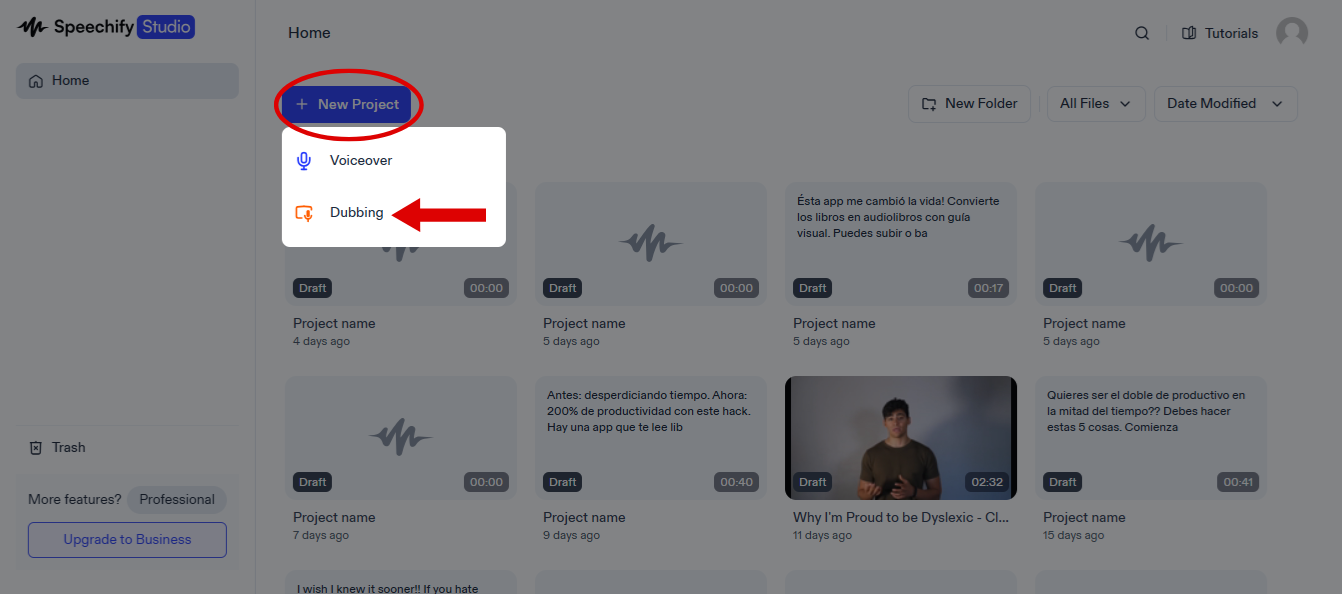
Upload your video: Import your video file into Speechify Studio. Specify the number of speakers, the original voice language (such as English, Swedish, Slovak, Danish, Czech, Dutch, Ukrainian, Russian, Finnish, Turkish, or Filipino), and adjust options like removing filler words or modifying pauses. Then, click “Submit.”
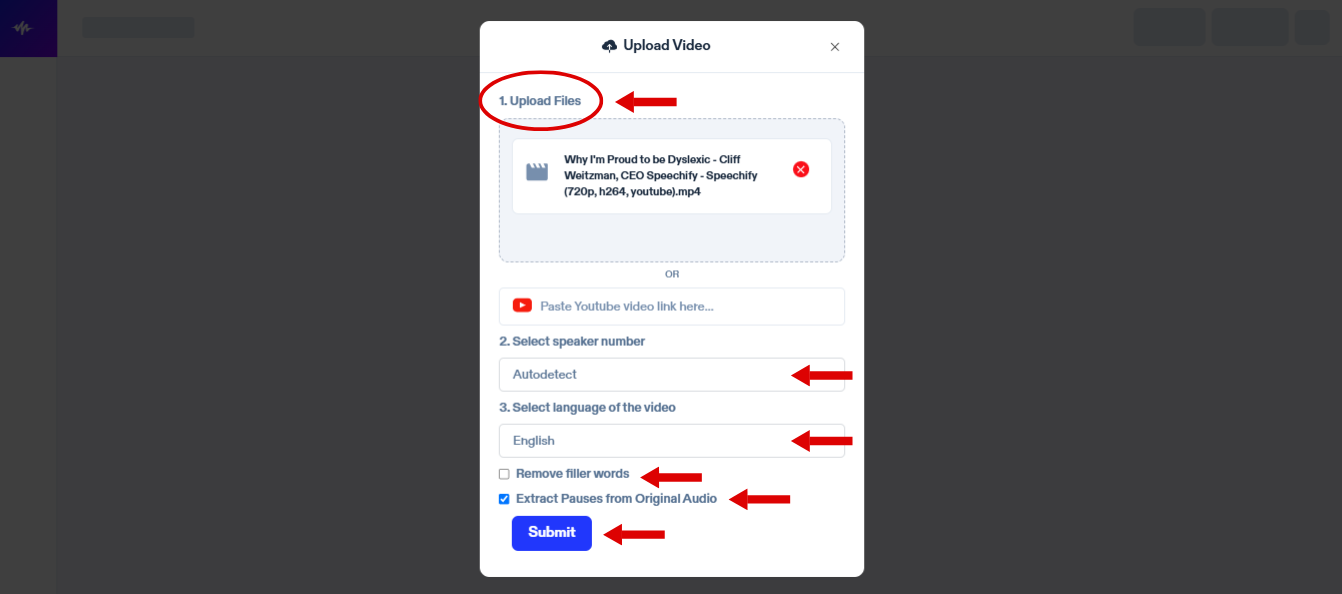
Transcribe the audio: Speechify Studio will transcribe your video’s audio into text automatically. You can review and edit the subtitles and transcription as needed.
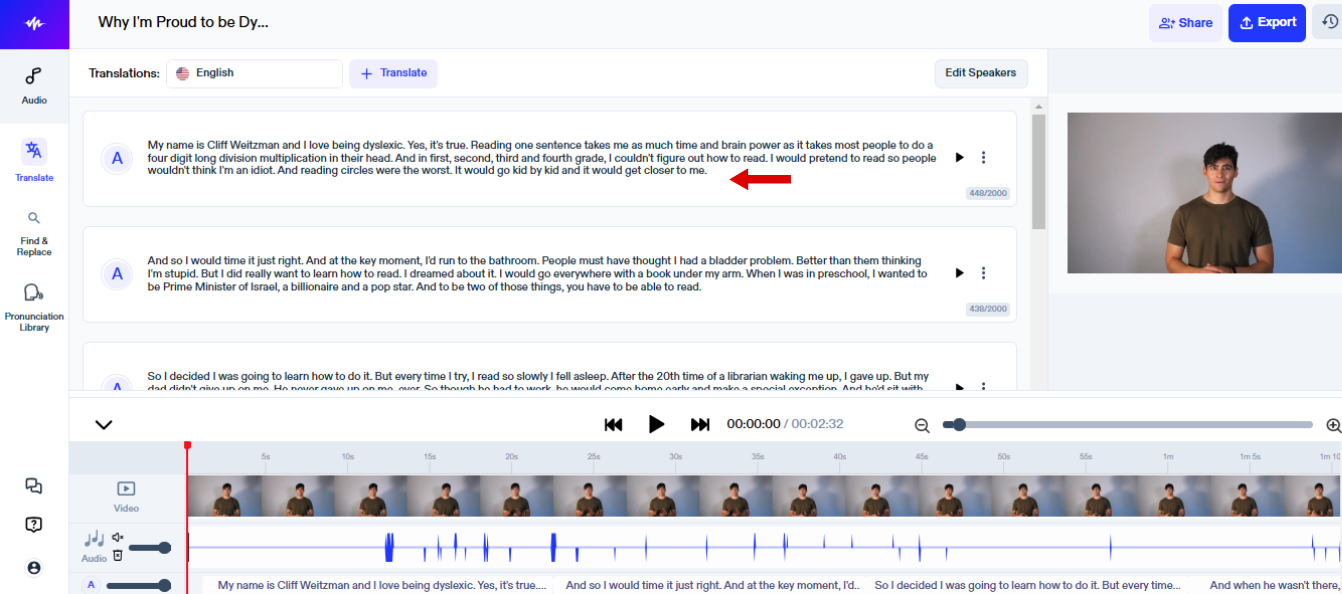
Set Italian as the target language: Under “Translate,” select “Italian” as your target language.
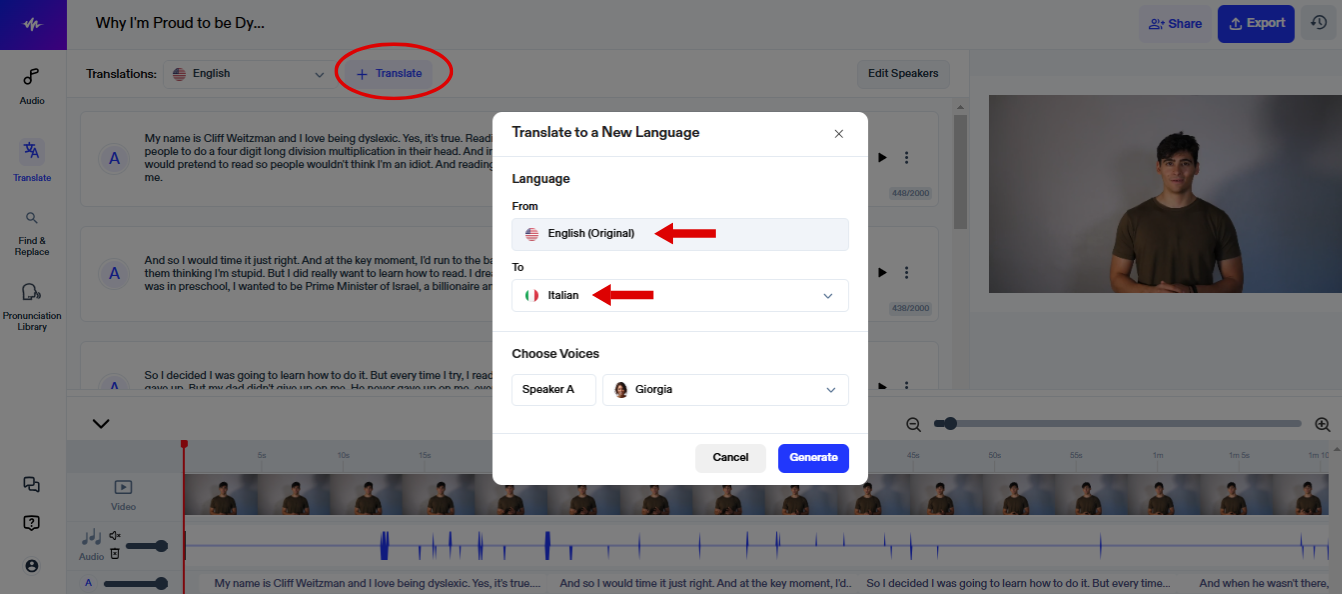
Choose an Italian voice: Assign each speaker a natural-sounding AI voice in Italian from the available options.
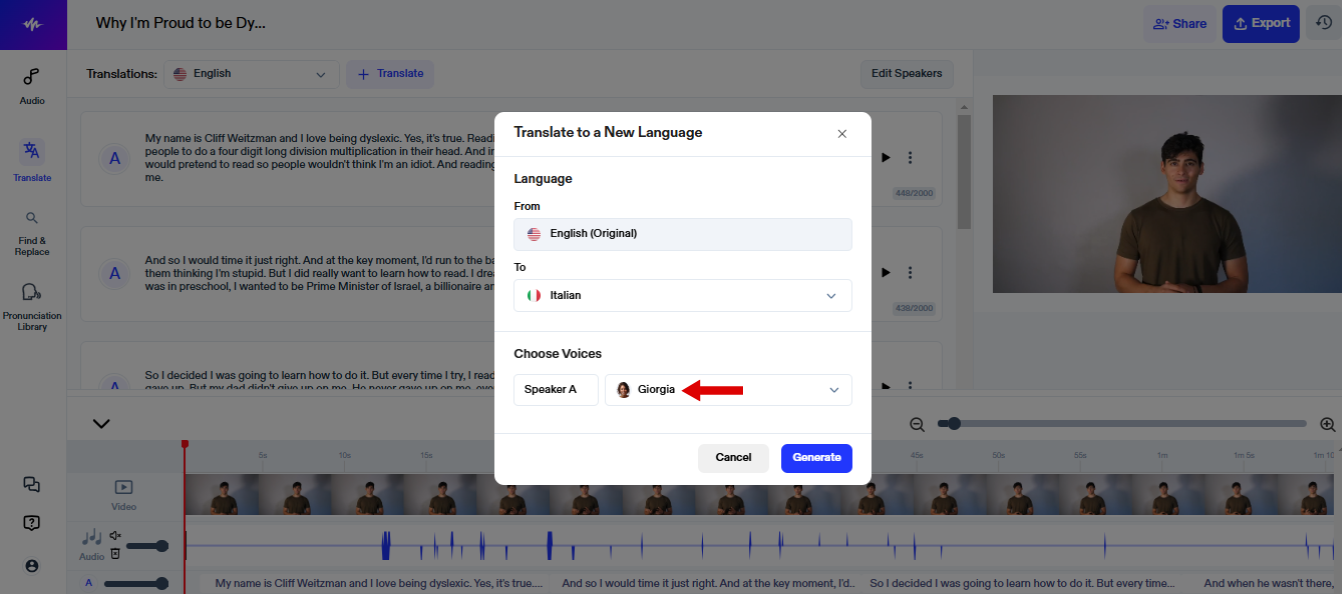
Generate the dubbed video: Click “Generate” to translate and synchronize the Italian dub with the video’s original lip movements.
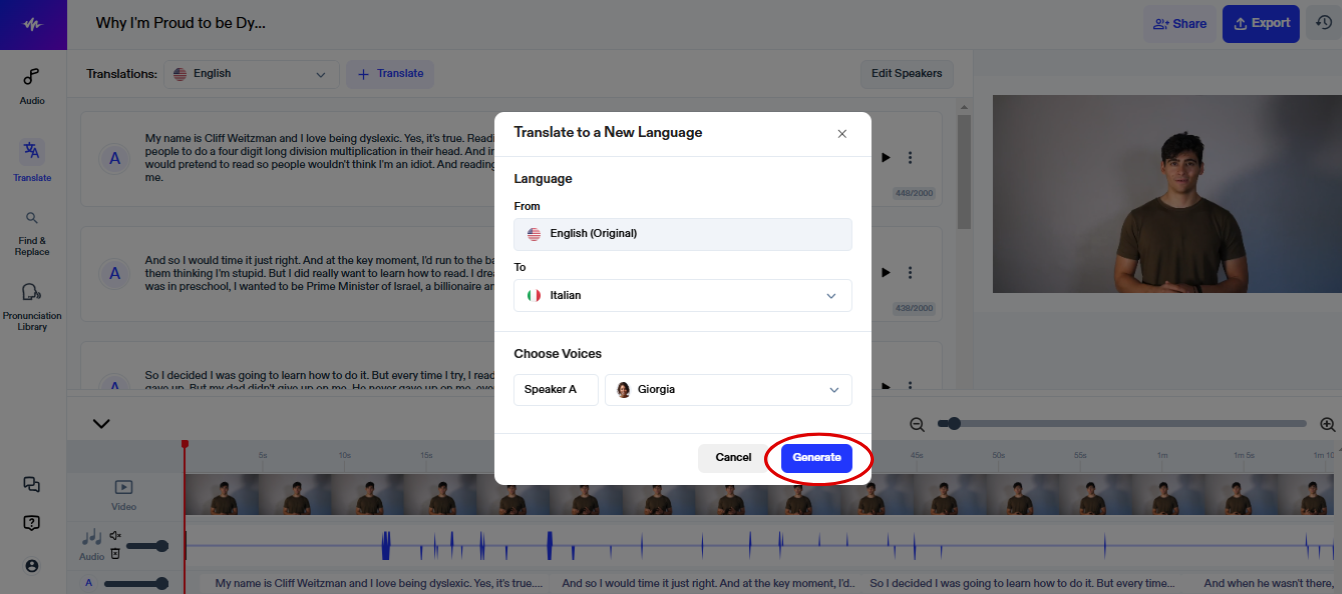
Export your dubbed video: Once the dubbing is complete, click “Export” to download your video with the new Italian voice over in your preferred format from the video translator.
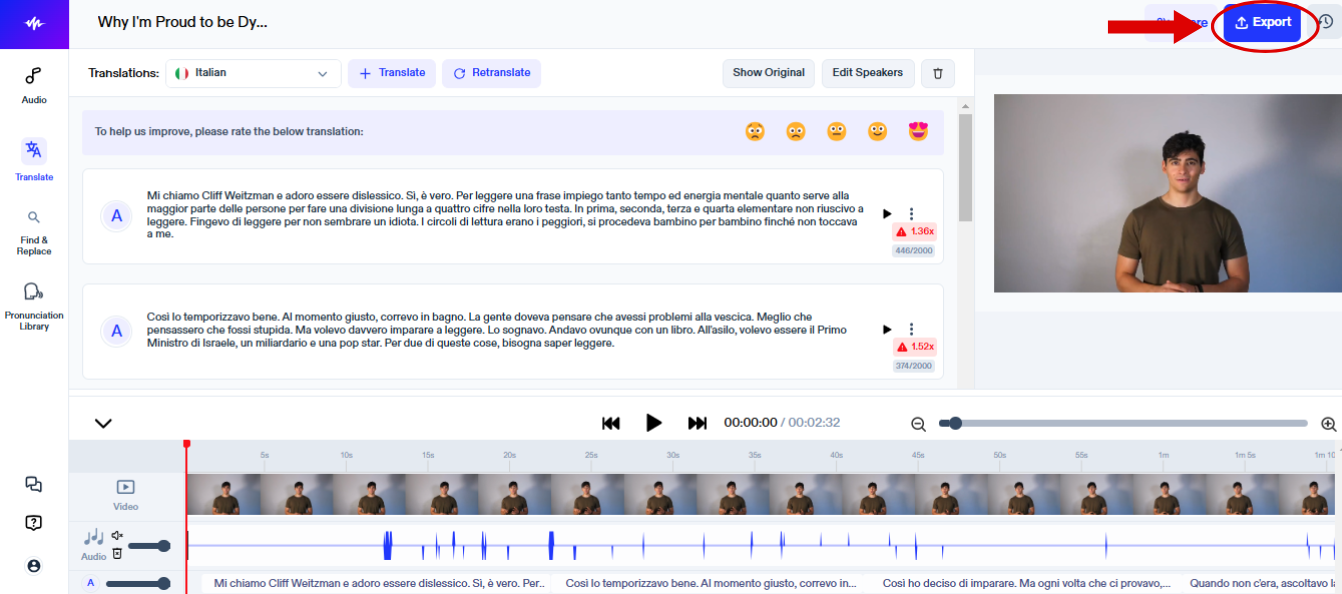
Speechify Studio’s Italian AI Voice Generator
Speechify Studio’s Italian AI voice generator is the best AI dubbing solution since it’s tailored to reflect the cultural and linguistic subtleties of Italian, providing a truly authentic and high-quality dubbing experience. Key features include:
- Wide selection of authentic AI voices: Speechify Studio offers over 200 realistic voices in different languages and accents—including Italian, Portuguese, French, German, Spanish, Korean, Russian, Polish, Tamil, Chinese, Japanese, Arabic, Greek, Hindi, Hungarian, Norwegian, Vietnamese, Mandarin, Croatian, Bulgarian, Bengali, Romanian, Malay, Indonesian, and more—allowing users to choose voices that match specific regional preferences.
- Variety of Italian accents and dialects: Speechify Studio’s AI voice generator includes 15 Italian voices, making it easy to select regionally appropriate voices to engage audiences from different areas of Italy.
- Sophisticated Italian AI voice cloning: With Speechify Studio’s Voice Over Studio, users can clone their own voices, maintaining their unique tone and style across projects, perfect for consistent personal branding or recurring characters.
- Enhanced pronunciation control: Users can adjust pronunciation line-by-line to capture distinct Italian sounds and expressions, ensuring that the final product feels authentic and true to the language.
- Comprehensive voice customization: Through Speechify Studio’s Voice Over settings, users can modify pitch, tone, and emotional delivery for dynamic voices; similar options will soon be available directly in the dubbing interface.
- Accurate representation of unique Italian sounds: The platform expertly captures Italian phonetics, handling details such as the rolled "r" sound and regional variations in intonation for clear and consistent pronunciation.
- Context-aware Italian translation: Speechify Studio adjusts translations to match the Italian context, adapting between formal and informal language. For example, it uses “tutto bene” in relaxed settings, while choosing more formal phrasing for professional contexts, capturing the subtleties of Italian culture.
- Emotion recognition and alignment: The AI recognizes the emotional tone of the original audio, such as joy, sadness, or sarcasm, and adjusts the dubbing to match the intended emotion effectively.
- Precise lip-sync technology: The platform offers refined lip-sync capabilities, ensuring dubbed Italian content aligns well with on-screen lip movements, even for more complex dialogues.
- Support for multiple speakers: Speechify Studio smoothly handles dubbing for multiple voices, distinguishing speakers and adjusting for language nuances, ensuring clear and accurate dialogue across multi-character scenes.
- Flexible integration with API access: Speechify Studio provides a versatile text to speech API, enabling businesses and developers to incorporate Italian AI dubbing and voice generation seamlessly into their platforms.
Benefits of Italian Dubbing with AI
With approximately 85 million people speaking Italian worldwide, including 65 million native speakers in Italy and around 20 million speakers in other countries, Italian dubbing opens doors to a culturally rich and engaged audience, especially within Italy. Here are some key advantages of using AI-driven Italian voices for dubbing:
- Precise localization: Italian has distinct vocabulary, pronunciation, and expressions that vary across regions. AI dubbing tools can tailor content specifically for Italian audiences, adjusting for accents like the Northern “Milanese” or Southern “Neapolitan,” ensuring that the dubbing feels authentic and resonates with audiences across Italy’s diverse regions.
- Improved engagement: Localizing content in Italian strengthens connections with Italian-speaking audiences, boosting engagement and viewer retention. Italian viewers are highly responsive to content that captures their unique linguistic and cultural nuances, enhancing relatability and enjoyment.
- Cost-effective solution: Traditional dubbing can be costly, especially when capturing Italy’s linguistic diversity. AI dubbing offers a more budget-friendly alternative, making professional-quality dubbing accessible for content creators and businesses of various sizes.
- Effortless scalability: AI-powered dubbing solutions make it easy to scale, allowing creators to localize individual videos or entire libraries into Italian quickly. This flexibility saves time, reduces production costs, and supports expansion into Italian-speaking markets.
Speechify Studio’s AI Voice Generator Understands Italian
Speechify Studio’s Italian AI voice generator goes beyond standard translation by delivering dubbing that authentically captures the nuances of Italian, adapting to regional dialects and expressions that make content resonate deeply with Italian-speaking audiences. Here’s how Speechify Studio addresses linguistic and cultural subtleties for high-quality, localized Italian dubs:
Pronunciation
Speechify Studio adapts to specific pronunciation patterns across Italian regions, creating a natural and familiar sound:
- Northern Italian accents: Known for a more clipped intonation, Northern Italian has softer “r” sounds and certain vowel shifts. Speechify Studio accommodates these nuances to deliver voice overs that sound authentic for audiences in regions like Milan or Turin.
- Southern Italian accents: Southern Italian is characterized by open vowels and a more rhythmic speech pattern. Speechify Studio captures these regional traits, ensuring that content feels familiar and genuine to viewers in areas like Naples and Sicily.
Vocabulary Differences
Speechify Studio incorporates regional vocabulary variations in Italian, ensuring that dubs reflect local context:
- Car: In Northern Italy, “macchina” is widely used, while in Rome, it’s more common to hear “auto.” Speechify Studio selects the appropriate term to maintain regional relevance.
- Young Man: The term “ragazzo” is standard across Italy, but in Naples, “guaglione” might be preferred. Speechify Studio adapts these terms naturally based on the target audience.
- Bread Roll: While “panino” is used generally in Italy, “rosetta” is popular in Milan, and “ciabatta” is preferred in other areas. Speechify Studio applies these differences for accurate localization.
Grammatical Nuances
Speechify Studio captures subtle grammatical differences, creating an authentic Italian experience for each region:
- Pronouns: In formal contexts, Italians use “Lei” for “you,” while in casual settings, “tu” is more common. Speechify Studio selects the appropriate form based on the tone and context of the content.
- Verb tenses: In Southern Italy, people might say “sto andando” for “I am going,” whereas Northern speakers often use “vado.” Speechify Studio adjusts verb usage to reflect these preferences.
- Possessives: Speechify Studio recognizes subtle differences in possessive expressions, such as the common use of “il mio/la mia” vs. “di me” in specific regions, for a more natural linguistic flow.
Cultural Sensitivity
Speechify Studio’s AI respects regional Italian expressions and culturally specific language to create a truly authentic experience:
- Greetings: In Rome, casual greetings like “Ciao” and “Come va?” are common, while in Northern Italy, “Salve” might be more frequent. Speechify Studio reflects these preferences to match the setting.
- Expressions: In Rome, “fico” is used for “cool,” while “figo” is popular in Milan. Speechify Studio uses the right term for relatable, region-specific dialogue.
- Local references: In Sicily, small local markets might be called “putìe,” while “alimentari” is more common in Northern Italy. Speechify Studio adjusts these terms to connect naturally with audiences.
By incorporating these Italian-specific linguistic and cultural details, Speechify Studio ensures that your content feels native to Italian-speaking audiences, enhancing relatability and regional appeal.
AI Dubbing: Text to Speech Italian AI Voices vs. Voice Cloning
AI dubbing allows you to customize content for Italian-speaking audiences, making it accessible and relatable across diverse regions within Italy. You have two main options: text to speech AI voices or voice cloning. Let’s look at each approach:
Italian Text to Speech Voices
Text to speech (TTS) technology is a fast and efficient way to create AI-generated voice overs in Italian. It converts written text into spoken language with pre-generated Italian voices that can be adjusted to reflect regional intonations.
For instance, using a TTS engine for a YouTube video aimed at an Italian audience, the system will not only translate text into Italian but also add natural inflections, ensuring that words like "grazie" or "ciao" are conveyed authentically. TTS is ideal for quick-turnaround content like social media videos and podcasts, as it handles rapid translation and vocalization.
Italian Voice Cloning
Voice cloning takes localization a step further by replicating a specific individual’s voice in Italian. This is particularly useful for brands and influencers who wish to maintain a consistent voice across multiple projects. For example, if an Italian influencer, such as Chiara Ferragni, wanted to expand content into English while retaining her unique voice in Italian for her primary audience, voice cloning can make this possible by using Italian AI-generated voice overs.
Voice cloning can even reflect distinct regional accents, such as a Roman or Neapolitan accent, preserving the authenticity of an influencer’s or brand’s voice. For creators and companies seeking both brand consistency and regional authenticity, voice cloning offers a transformative solution.
Speechify Studio Use Cases for Italian AI Dubbing
Popular Italian podcasters like Alessandro Masala (Breaking Italy) and Fedez (Muschio Selvaggio) can expand their reach by creating English-dubbed versions of their content. Similarly, international podcasts like Joe Rogan or Serial can be dubbed into Italian, making global content accessible to Italy's 60 million native speakers. Speechify Studio could particularly benefit news podcasts like Il Podcast di Alessandro Barbero where timely content needs quick localization.
AI Voices for Italian Social Media
Leading Italian influencers like Chiara Ferragni (29M+ followers) and Khaby Lame can use AI dubbing to reach non-Italian audiences while maintaining their authentic voices. Major platforms like TikTok Italia and Instagram Italia see millions of daily active users who prefer content in Italian. Food influencers like GialloZafferano can also create multilingual recipe videos efficiently using Speechify Studio’s AI dubbing.
AI Voices for Italian Multilingual Marketing Campaigns
Global brands like Nike, Apple, and McDonald's regularly create Italian dubbed campaigns. For example, Coca-Cola's "Taste the Feeling" campaign needed distinct Italian versions for the local market. Companies like Barilla, which operates globally but maintains strong Italian identity, can also use Italian AI voices to maintain consistent branding across markets while speaking authentically to Italian audiences by using Speechify Studio.
AI Voices for Italian Audiobooks
Major publishers like Mondadori and Feltrinelli can expand their audiobooks catalogs by using AI voices to narrate classic Italian literature from authors like Elena Ferrante, Italo Calvino, and Umberto Eco. International bestsellers can also be quickly dubbed into Italian, reducing the months-long traditional recording process to days, thanks to Speechify Studio.
AI Voices for Italian Entertainment
Italy has a strong dubbing tradition, with studios like SEDIF and CDC Sefit Group handling major productions. Netflix Italia, Disney+, and Amazon Prime regularly dub content into Italian. Popular series like Stranger Things or The Mandalorian could also use Italian AI voices for faster localization and major Italian productions like Gomorra or L'Amica Geniale could similarly be dubbed into other languages efficiently with the help of Speechify Studio.
AI Voices for Italian Educational Content
Educational and e-learning platforms like Coursera and edX can localize their courses for Italian learners. Local institutions like Università di Bologna or Politecnico di Milano can create multilingual content for international students with Speechify Studio. Language learning apps like Duolingo and Babbel can also enhance their Italian courses with AI-generated native pronunciations.
AI Voices for Italian Video Games
Gaming giants like Ubisoft, EA, and Nintendo regularly dub video games into Italian. Popular titles like Assassin's Creed (which often features Italian settings) or FIFA (with its large Italian following) require extensive voice work that AI such as Speechify Studio could streamline. Italian gaming studios like Milestone S.r.l. could also use Italian AI voices to dub their games into multiple languages efficiently and reach a global audience.
AI Voices for Italian Accessibility
Major broadcasters like RAI, Mediaset, and Sky Italia need to provide accessible content. Italian AI voices can help quickly create audio descriptions for visually impaired viewers and dub foreign content for hearing-impaired audiences who rely on lip-reading in their native language. Italian news websites like Repubblica.it and Corriere.it could also use Speechify Studio’s AI voices to convert written articles into audio content.
Competitors to Speechify Studio with Italian AI Voice Capabilities
While Speechify Studio stands out as a leading AI dubbing platform, several other tools also offer high-quality Italian AI voice generation. Here’s a comparison of Speechify Studio alongside other platforms providing Italian AI voices:
Speechify Studio
With support for over 150 languages and accents, including multiple Italian voices, Speechify Studio’s AI voice generator is a robust and adaptable dubbing and video editing solution for professionals across fields. This platform captures not only the speaker’s emotion, timing, and tone but also their unique vocal qualities, producing a highly realistic and nuanced audio experience. Additional tools like multi-speaker support, auto-subtitling, extensive stock media access, advanced voice cloning, and lifelike text to speech options make Speechify Studio ideal for those seeking a comprehensive and flexible tool that can handle complex dubbing needs, from corporate training videos to creative projects.
ElevenLabs
ElevenLabs brings intuitive editing to the forefront with support for 29 languages, allowing users to preserve the original speaker’s emotional tone, timing, and intent seamlessly. Known for its natural-sounding AI voices, ElevenLabs supports multi-speaker dubbing and voice cloning. The platform’s editing features make it easy to handle complex audio requirements, making it an excellent solution for content creators, marketing teams, and educational media developers who need versatile and realistic Italian AI voices.
Rask
Rask is tailored specifically for cinematic and high-quality visual projects, supporting 135 languages with advanced capabilities such as voice cloning, multi-speaker options, and detailed lip-syncing for immersive results. Perfect for Italian filmmakers and video editors who prioritize fluid and professional-grade voice integration, Rask’s dubbing technology maintains the original speaker’s characteristics while ensuring a synchronized, seamless blend with on-screen visuals. This platform is catered to film productions, documentaries, and creative projects that need voice overs to enhance storytelling without sacrificing quality.
Murf
Murf provides a solution that prioritizes emotional depth and vocal fidelity, supporting over 20 languages with a focus on retaining the speaker’s original tone, style, and nuances. Equipped with Italian voice cloning and text to speech features, Murf is well-suited for projects that require nuanced, expressive voice overs, catering to professionals in fields such as advertising, narration, and podcasting. Murf’s advanced capabilities allow users to achieve a high level of vocal expressiveness, making it a valuable asset for professional audio production teams who need to convey authenticity in their voice overs.
DupDub
DupDub, with support for over 70 languages and a variety of accents, offers a reliable Italian dubbing solution complete with auto-subtitles, multi-speaker capabilities, and lip-syncing, ensuring that the speaker’s original style and intention are preserved. This platform’s features make it an excellent choice for professionals who prioritize accuracy and realism in voice cloning and text to speech, making it particularly suited for e-learning, corporate training, and localization projects that require clear and nuanced voice overs in multiple languages.
Dubverse
Dubverse supports a broad range of over 60 languages, offering features such as auto-subtitling, contextual translations, and lip-syncing that allow for precise linguistic adaptation. With its flexible Italian pronunciation options and tonal variations, Dubverse is a versatile tool that accommodates diverse language needs, making it suitable for marketers, content creators, and businesses that operate in multilingual markets. Its adaptive voice cloning and text to speech capabilities ensure that the voice over matches the desired tone and context, enhancing the effectiveness of localized content.
Wavel
Wavel’s catalog covers over 70 languages and is built with tools to achieve up to 95% accuracy in preserving the original tone, style, and timing of the speaker. It includes multi-speaker support, advanced synchronization features, and AI-powered voice cloning, making Wavel a great option for Italian projects that require meticulous attention to vocal precision, such as training programs, instructional videos, and documentaries. Its attention to detail makes it well-suited for high-stakes projects where fidelity to the original content is paramount, allowing creators to achieve professional-grade results.
InVideo
Supporting over 50 languages and accents, InVideo is optimized for team projects, providing a collaborative platform with multiplayer editing and access to a vast library of 16 million stock media files. Its Italian voice cloning and text to speech capabilities make InVideo an ideal solution for organizations that work on large-scale media projects, enabling them to create cohesive, multilingual content. The platform’s resources make it well-suited for corporate videos, marketing campaigns, and educational content, providing a centralized solution for teams that need access to both media assets and advanced voice over features.
Embracing the Future of Italian Dubbing with AI
AI-powered dubbing solutions like Speechify Studio make it possible for Italian content creators, brands, and educators to reach Italian-speaking audiences effectively and affordably. As AI technology advances, Italian-specific voice generation will continue to play a pivotal role in transcending language barriers and bringing Italian audiences closer to global content. Whether you’re a brand looking to localize for Italian markets or a creator wanting to connect with Italian viewers, AI voice generation opens up new possibilities tailored to Italy's unique media landscape.
FAQ
How can I dub a video in Italian with AI?
Dub your video in Italian with ease using Speechify Studio's Italian AI-powered dubbing, which offers realistic Italian voice options and seamless language integration at affordable pricing.
How can I dub a video in another language online?
Speechify Studio lets you dub videos in any language online, providing AI-driven dubbing that captures tone and timing authentically.
How do I translate an Italian video into English?
Use Speechify Studio to translate and dub Italian videos into English with precise voice matching and natural translation.
What is the best AI dubbing tool for English to Italian?
Speechify Studio is the top AI dubbing tool for converting English videos into Italian, combining accurate translation with expressive AI voices.
What is the best AI-powered Italian text to speech service for video dubbing?
For the best Italian text to speech service in video dubbing, Speechify Studio offers lifelike voices and easy integration with video content.
What is the best free Italian video dubbing AI?
Speechify Studio provides a free trial for Italian video dubbing, allowing users to experience high-quality AI dubbing at no cost.





